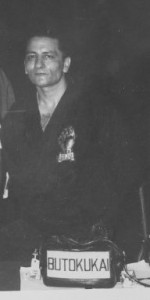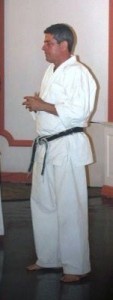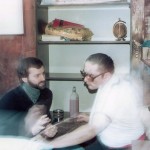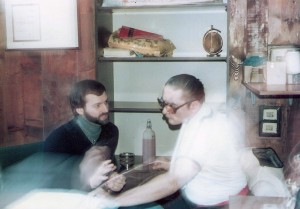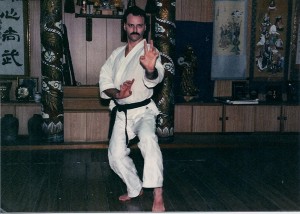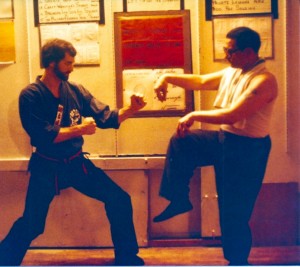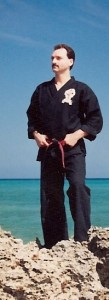La Sindrome di Peter Urban 2
Questo è il secondo articolo della serie intitolata “La Sindrome di Peter Urban“.
Il compianto Gran Maestro Peter Urban non fu solo il pioniere delle prime scuole di arti marziali negli Stati Uniti, nel 1959, ma fu anche un eccentrico innovatore, un eclettico propagatore di nuovi e moderni approcci alle Arti Marziali.
In un periodo in cui, la maggior parte degli insegnanti di arti marziali, erano innamorati della “tradizione”e si impegnavano a seguire queste “tradizioni” decretate dai loro predecessori orientali, Master Urban diede il via a quello che molti considerarono un “sacrilegio“, iniziando a deviare, apertamente, dalla gran parte delle mentalità e dalle pratiche “tradizionali”che erano il cuore della cultura orientale e di quella società che in precedenza aveva concorso in modo importante alla fondazione della Arti Marziali Orientali.
Ad oggi, i risultati di quella “ribellione” sono ancora osannati da alcuni, compianti e criticati da altri. Tuttavia, questo CAMBIAMENTO DI MODELLO aprì la via ad una transizione nelle arti marziali che ancora oggi è in corso. In precedenza si rifletteva in molti dei concetti “radicali” anti-tradizione presentati dal compianto Bruce Lee negli anni 70, esemplificata poi nelle molteplici variazioni nello stile Goju USA, avviato da GM Urban e poi avanzato dai suoi allievi più importanti, oggi è parte del mantra che alimenta il fenomeno delle molto popolari “Mixed Martial Arts“. Per contro invece, molte delle pratiche più radicali di Urban, hanno creato precedenti problematici, che hanno causato gravi questioni sulla credibilità del sistema di classificazione delle cinture nelle Arti Marziali.
Come molti altri personaggi di spicco nella storia, il Gran Maestro Urban ha avuto talentuose realizzazioni ma anche alcuni “demoni”. Con il massimo rispetto per i suoi numerosi successi, e come uno dei suoi più stretti e a lungo termine studenti senior, devo ammettere che non ho mai avuto l’illusione che quell’uomo fosse un santo o senza colpe. A mio parere, solo attraverso un esame candido, onesto e critico della storia potremo meglio muovere in avanti le arti marziali. Come mi piace spesso ricordare, Winston Churchill disse : “Coloro che non imparano dalla storia sono destinati a ripeterla”.
Non è mia intenzione soffermarmi sul passato, o romanzare “storie di guerra” e di “eroi” o condannare discutibili azioni e attività del passato, è tuttavia, nostra responsabilità come adulti, come Maesrti Senior e attuali leader delle arti marziali di visualizzare il tutto con una “mente critica“e aperta a tutte le possibilità, ma allo stesso tempo essere consapevoli che non tutto è accettabile o redditizio. Infondo, desidero solo onorare uno dei più preziosi principi che mi insegnò questo grande artista marziale: “TIENI IL BUONO e SCARTA IL CATTIVO”. E’ con questo spirito che continuo a esaminare e a condividere, con umiltà e verità “LA SINDROME DI PETER URBAN” (more…)
The “PETER URBAN SYNDROME” 2
This is the second in a series of articles titled, “The Peter Urban Syndrome”.
The late GrandMaster Peter Urban was not only a Pioneer originating one of the 1st Martial Arts schools in the USA in 1959 but he was an innovator and somewhat eccentric, eclectic propagator of newer and more modern approaches to the Martial Arts.
During a period when most martial arts teachers were enamored with “tradition” and committed to following established “traditions” of their oriental predecessors, Master Urban initiated what many considered a “Sacrilege” as he began to openly deviate from much of the “traditional” mindset and practices that where at the heart of oriental culture, society, and previously had formed a major part of the foundation of oriental martial arts.
To this day, the results of this “Rebellion” are still lauded by some, lamented and criticized by others. However, this PARADIGM CHANGE began a transition in martial arts that is still in progress today; reflected later in many of the “radical” anti-tradition concepts presented by the late Bruce Lee in the 70’s, exemplified in the multiple variations of the USA GoJu style initiated by GM Urban and further advanced by his most prominent students, and has become part of the mantra that helps fuel the present “Mixed Martial Arts” phenomenon currently popular today. In contrast, many of Urban’s more radical practices have served to set problematic precedents that have resulted in serious questions concerning credibility in the MA belt ranking system.
As with any prominent figure in history, Grand Master Urban had his remarkable accomplishments along with his “demons”. With the greatest respect for his many accomplishments, and as one of his closest, long term Senior Students, I have no illusion that this man was a Saint or was without fault. It is the opinion of this author that only through candid, honest, and critical examination of history will we best move our martial arts forward. As Winston Churchill stated, “Those who do not learn from the history are destined to repeat it.”
It is not my intention to dwell on the past whether by romanticizing “war stories” and/or “heroes” or by condemning questionable past actions and activities. It is, however, our responsibility as adults, as Senior Masters, and present leaders of the martial arts to view all with a “critical mind”, a mind open to all possibilities but cognizant that not everything is probable, and/or profitable. Ultimately, I wish to honor one of the valuable principles taught to me by this great martial artist, “KEEP THE GOOD and DISGARD THE BAD”. It is in this spirit that I continue to examine and share, in humility and truth, “THE PETER URBAN SYNDROME”. (more…)
Where do we go from here?
The following is an article submitted by a guest author, Manny Saavedra, Hanshi. He is the HeadMaster and Founder of the World Sansei GoJu organization, headquartered in Miami, Florida. He is one of the Senior Masters who’s roots began in USA GoJu as a student of GrandMaster Peter Urban. He founded the Sansei GoJu organization in 1979 at the same time I began my work on A.G.K.A.I. and has established one of the most credible GoJu-ryu international organizations in the world. I am blessed to call him my friend and GoJu brother.
We are honored to have him as a guest author at MARTIAL ARTS INSIDER, and I am blessed to benefit from the wisdom of his counsel. Please enjoy the article and feel free to comment and/or pose questions at the end in the comment section after this article. Our BLOG is set up to be interactive and he will be able to respond directly to any inquiry as his busy schedule permits.
SHIHAN RIC PASCETTA
…the first appearance deceives many; the intelligence of a few perceives what has been carefully hidden.
As a visual reference, a family tree is an excellent way to think about the connections between individuals, especially in large families. Historians often create a family tree, especially when they are looking at the history of royal dynasties, to follow the paths of allegiance and relation between various nations. A family tree can illustrate what exactly a second cousin is, for example, or show you the precise relationship between yourself and your step-great-aunt. In historical situations where families have tended to intermarry, a family tree can sometimes get confusing, and the linear nature is corrupted by lines which appear to sprout in all directions. So it is that we do the same in Karate.
For us in karate, a family tree showcases the connections and history of a family system. Most of us are proud of their relationships to famous these figures, and are delighted to have a family tree illustrating that point. The family tree can serve as a small history lesson of the family, showing the various origins of different members of the family, along with the children (students) they had and when they lived. It can also serve as a memory prompt, because seeing the family member’s name can bring out other pieces of the individual’s history, such as what he or she did that was distinctive or remarkable.
The Art above the Artist
For a tree to proliferate the branches must grow to gather nutrients for the trunk. There are no favorite branches and all are loved, all are part of the living tree. Some branches will survive the winter, some the rain, some will bend with the wind and some will break. Some of the branches will plant seeds. All are needed and are viewed as part of the one, part of the Toa, the natural order of life. It is within this natural order of life that all things must follow, and we as USA Goju lineage must learn to work together one way or another. (more…)
La “Sindrome di PETER URBAN”
Questo articolo parte da una serie di post incentrati sull’attuale questione che mette a confronto coloro che hanno beneficiato dei molti e positivi contributi che il defunto Patriarca dell Goju USA, Peter Urban, ha portato alle Arti Marziali, e coloro che invece hanno sofferto per alcune pratiche negative o da abusi, adottati da coloro che hanno studiato, insegnato, o in qualche modo sono stati associati direttamente a questo Pioniere delle AM o ai suoi seguaci. Questa serie non è destinata a diffamare o attaccare nessuno in particolare, ma è solamente una mia opinione, basata sulle mie personali esperienze, osservazioni e conclusioni. Vi prego di considerare la cosa con obbiettività.
Oggi ho risposto ad un post sulla pagina di Facebook: “U.S.A.G.A. Urban System of America GoJu Association“. In questo post, un membro dell’USAGA scriveva: “E’ tempo per te di prendere in consegna l’USAGA ….”. Dal momento che prendo molto sul serio questo argomento, vorrei condividere il contenuto della mia risposta con chiunque sia interessato al tema del GoJu USA. Vi prego di leggere qui di seguito la più accurata e particolareggiata versione della mia risposta.
U.S.A.G.A. Urban System of America GoJu Association: grazie amico per il gentile complimento e l’espressione di fiducia. Tuttavia, non sta a me “take over “(rilevare) l’USAGA. Se fossi così sciocco a desiderare questo, non sarei niente di diverso da molti altri che sembrano perseverare nel rivivere il passato, approfittando del lascito di Peter Urban, alla faccia o alle spalle di tanti altri legittimati Maestri del GoJu USA, i quali, pochi sono quelli più Senior di me, di più invece i più giovani .
Peter Urban in persona, mi ha insegnato che il primo passo in una organizzazione, è quello di classificare tutto “accuratamente”, la parola chiave è appunto”accuratamente”. Non importa quanto si vuole idealizzare il passato, non potremo mai cambiare la realtà o ri-scrivere la storia. (more…)
The “PETER URBAN SYNDROME”
This article is one of a series focused on issues currently challenging those who have benefited from both the multitude of positive Martial Arts contributions of the late Patriarch of USA GoJu, Peter Urban, and also those who have suffered from some of the negative practices and abuses connected with those who have studied, practices, taught, or associated with this MA Pioneer and his followers. This series is not intended to defame or attack anyone personally, but is solely the opinion of the author, based on his personal experiences, observations and conclusion. BE ADVISED, Enter with a critical mind.
Today I responded to a post on the Facebook Page: “U.S.A.G.A. Urban System of America GoJu Association“. This post by a U.S.A.G.A.member stated: “It’s time for you to take over U.S.A.G.A….”. Since I take this subject very seriously, I subsequently wish to share the contents of my response to anyone interested in the subject of USA GoJu. Please read below an edited and more thoroughly revised version.
U.S.A.G.A. Urban System of America GoJu Association: Thank you for the kind compliment and expression of trust. However, USAGA is not mine to “take over”. If I was so foolish to attempt that, I would be no different than those others who seem bent of reliving the past, taking advantage of Peter Urban’s legacy, in the face and on the backs of so many other legitimate USA GoJu Masters, a few Senior to me and many Junior to me.
Peter Urban personally taught me that the first step in organization was to label everything “accurately” and the operative word here is “accurately”. No matter how much we wish to romanticize the past, we can never change reality or re-write history.
Chiamata alle Armi per tutti gli Artisti Marziali
Questo post è il primo di una serie di articoli sul tema: “Ripristino dell’ INTEGRITÀ, ONORE e RISPETTO nelle Arti Marziali”. Niente di quello che è scritto qui è inteso come atto di accusa nei confronti di una persona o organizzazione in particolare. E’ semplicemente un un tentativo di fare luce e verità su alcune pratiche e norme molto ambigue ed emergenti, che, pare abbiano iniziato a minare molti dei migliori benefici nell’attività delle arti marziali. Se noi, sia appassionati praticanti e presunti “LEADERS” delle Arti Marziali non sappiamo vivere nella VERITA’, GIUSTIZIA ed INTEGRITÀ, allora continueremo a vedere il degrado di quelle pratiche che ci hanno dato grandi benefici e di conseguenza si arriverà alla scomparsa dei frutti per i quali, nobili predecessori, hanno sacrificato molto affinchè noi possiamo goderne oggi Vi prego di unirvi alla discussione, in modo costruttivo e positivo. L’unione fa la forza. Cerchiamo di lavorare insieme per stabilire e mantenere Forza e Giustizia!
PARLARE O FARE?
Come ho già sostenuto, la differenza tra “Tecnica” Marziale e “Arte” Marziale sta nel fatto che, nello sviluppo delle Arti Marziali esiste la specifica opportunità dell’inclusione di tutte le aree di sviluppo del potenziale umano: fisico, intellettuale, emozionale e spirituale. Questi valori, ipoteticamente, sono impliciti nel termine “DO” (DAO), a volte tradotto e interpretato come la “Via” o “Sentiero”. (vi raccomando di non confondere questa “filosofia” con la “religione” chiamata “taoismo”, anche se possono esistere alcuni paralleli.)
Noi, tuttavia, come praticanti di arti marziali e presunti dirigenti abbiamo una responsabilità molto più grande, non solo di “predicare bene” ma anche di “razzolare bene”. Come in molti altri campi umani, suonano meravigliose le parole altisonanti e possono essere fonte di ispirazione per molti. Il problema principale in questa”etica” è la sfida, per ognuno di noi, di mettere in pratica le nostre belle parole e filosofie. “AZIONI congrue formano la sostanza di ogni presunta filosofia”
(more…)
A CALL to ARMS to all Martial Artists
This post is the first in a series of articles under the topic; “Restoring INTEGRITY, HONOR, and RESPECT to the Martial Arts”. Nothing written here is intended as an indictment against any particular individual and/or organization. It is simply an effort to shed the light of truth on some very significant practices and emerging “norms’ that appear to have begun to undermine many of the most positive benefits of martial arts activity. If we, the passionate practitioners and alleged “LEADERS” of the Martial Arts do no stand together for TRUTH, JUSTICE, and INTEGRITY, then we will continue to see the degradation of those things which have benefited us greatly and the subsequent disappearance of the fruits of those noble predecessors who sacrificed much so that we can enjoy what we have today. Please join in the discussion, constructively, and positively. There can be strength in numbers, however, history has shown us that even a few passionate and determined patriots can ignite the brushfires of a justifiable revolution. Let us work together to establish and maintain Might for Right!
WALK or TALK?
As I have previously contended, the difference between Martial “Technique” and Martial “Art” is that with Martial Arts training there exists the uniquely specific opportunity for the inclusion of all areas of development of the full human potential: Physical, Intellectual, Emotional, and Spiritual. The hypothetical search for balance and harmony between these human aspects and the noble principles learned are implied by the term “DO” (DAO), sometimes translated/interpreted as the “WAY” or “PATH”. (Please do not confuse this “Philosophy” with the “Religion” named, “Daoism”, although there may exist some parallels.)
We, however, as martial arts practitioners and alleged leaders have a much greater responsibility to “WALK the WALK”, not just “TALK the TALK”. As with many other human endeavors, our flowery words sound wonderful and can be inspiring to many. The primary issue presented along with these “ethics” is the challenge to each of us to put our high sounding words and philosophy into ACTION. “Congruous ACTION forms the substance of any alleged philosophy.”
MMA – Il Buono, il Brutto, e il Cattivo – Parte 2
L’articolo seguente (Parte 2 di 2 parti ) è stato ispirato da una serie di commenti scritti su un mio post da un istruttore cintura nera che ha studiato prima con uno dei miei allievi diretti e poi ha ampliato la sua esperienza studiando Brazilian Jiu-jitsu. Ho leggermente modificato alcuni dei brani, per condividere i contenuti della nostra discussione con tutti i lettori.
L’istruttore mi raccontava le sfide che aveva dovuto affrontare quando aveva tentato di aggiungere un programma di MMA al suo curriculum, e il suo conseguente e notevole grado di insoddisfazione. Potete trovare le sue osservazioni originali scritte sotto il mio precedente articolo dal titolo “Tradizione vs MMA – Parte 4“.
Nelle sue osservazioni, il mio studente di seconda generazione, include anche la “lezione” non proprio positiva che aveva imparato da questa storia. La Parte 2 di questa serie, scritta qui sotto, e’ la continuazione delle mie risposte e rimane in contesto con i suoi commenti..
RIFLESSIONI
Molti anni fa, come giovane Sensei e molto prima che le MMA diventassero così popolari, feci alcuni errori simili a quelli lamentati dall’allievo del mio studente nella Parte 1 di questa serie. In un tentativo sincero di rimuovere ciò che scambiavo per “egoismo” dal mio insegnamento, iniziai a modificare un po’ la struttura formale nel mio dojo e a sostituire me stesso con un’immagine simile a quella di un “coach” di una “palestra”.
Diventai permissivo con il protocollo del dojo, sullo scambio di cortesie (inchino, ecc) cominciammo a chiamarci per nome socializzando anche al di fuori del dojo più come “pari”. Non dovette passare molto tempo prima che mi rendessi conto cosa voleva dire sfocare le linee, non separando studente e Maestro, in particolare, quella della responsabilità “dell’esempio” che ogni leader forte o mentore deve dare ed essere per non diventare come “uno dei ragazzi”. (more…)
MMA – The Good, the Bad, and the Ugly – Part 2
The following article (Part 2 of a 2 part series) was inspired by a number of comments posted by a serious Black Belt instructor who studied with one of my direct students and then expanded the ground aspect of his own MA experience by studying Brazilian Jiu-jitsu. I have slightly modified some of the excerpts from my responding comments in order to share the content of our discussion with our general readers.
This instructor explained the challenges he endured when he attempted to add an MMA program to his curriculum, subsequently resulting in a significant degree of dissatisfaction. You can find his original comments written at the end of my previous article titled, “MMA vs. Tradition – Part 4“.
In these comments submitted by my second generation student, he included the “lessons” he had learned from not so positive experience. Part 2 of this series, written below, is a continuation of my responses and remains in context with his comments.
REFLECTIONS
Many years ago, as a young Sensei and long before the recent MMA popularity, I also made some mistakes similar to those lamented by my student’s student in Part 1 of this series. In a sincere attempt to remove what I mistook for “egoism” from my teaching I began to replace the somewhat formal structure in my dojo and began to run it more like a “coach” in a “gym”.
I became lax with dojo protocol such as exchanging courtesies (bowing, etc.) We called each other by first name and even socialized outside the dojo more like “peers”. It wasn’t until much later that I realized how significantly this began “blurring the lines” separating student and Master teacher, particularly, the responsibility to “set the example” that any strong leader and/or mentor must do and not allow himself to become “one of the boys”. (more…)
MMA – Il Bello, il Brutto e il Cattivo – Parte 1
L’articolo seguente (Parte 1 di 2 parti ) è stato ispirato da una serie di commenti scritti su un mio post da un istruttore cintura nera che ha studiato prima con uno dei miei allievi diretti e poi ha ampliato la sua esperienza studiando Brazilian Jiu-jitsu. Ho leggermente modificato alcuni dei brani, per condividere i contenuti della nostra discussione con tutti i lettori.
L’istruttore mi raccontava le sfide che aveva dovuto affrontare quando aveva tentato di aggiungere un programma di MMA al suo curriculum, e il suo conseguente e notevole grado di insoddisfazione. Potete trovare le sue osservazioni originali scritte sotto il mio precedente articolo dal titolo “Tradizione vs MMA – Parte 4“.
In queste osservazioni, il mio studente di seconda generazione, iniziava il suo discorso con il termine “tradizionale” per riferirsi al suo uso del sistema GoJu Usa di arti marziali. La mia risposta inizia in quel contesto.
Che cosa è “Tradizionale”?
La questione che vorrei far notare, innanzitutto, è una discrepanza, percio’ suggerisco di fare un uso più preciso del termine “tradizionale”. In primo luogo, USA GoJu è stato tutt’altro che “tradizionale”. E ‘stato un sistema ibridato dal Gran Maestro Peter Urban dopo avere chiuso con Yamaguchi Goju-Kai nei primi anni ’60. Vi ricordo che egli studiò sotto tre Maestri molto titolati, Richard Kim (Okinawa Shorinji Kempo, Ryu), Gogen Yamaguchi (Giappone Goju-ryu). e Masatatsu Oyama (Kyokushin, che includeva elementi di Shotokan, Goju-Ryu, e la boxe thailandese).
In realtà, il sistema insegnato da GM Urban era, come ho su scritto, ibrido. Era basato sì, su concetti primari e fondamentali del Kata e del Goju-Ryu, ma comprendeva anche altri elementi attinenti pertinenti che aveva imparato dal GM Kim e dal GM Oyama. Inoltre, GM Urban era molto innovativo, e aggiunse al suo stile unico, altre forme che uscivano dalla sua mente ispirata, ma allo stesso tempo, anche prodotto e risultato di una ricerca e di studi molto razionali.
Il primo MMA
Quello che ho descritto sopra è il patrimonio che determina e dscrive attualmente il Goju USA. E’ stato forse uno dei primi veri e propri sistemi di “Mixed Martial Arts” negli Stati Uniti. La differenza sostanziale, tuttavia, è che questo sistema viene insegnato come vera e propria Arte Marziale, non semplicemente come un agglomerato di “TECNICHE” Marziali. (more…)
